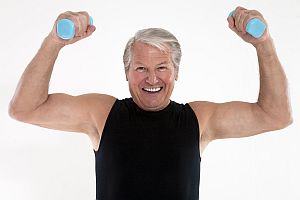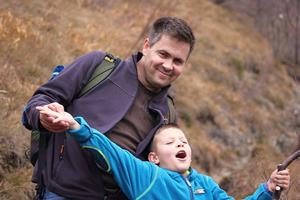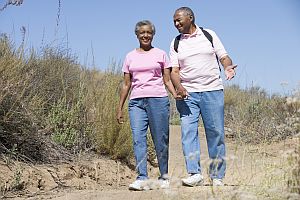Building Better Bones for the Long Run

When it comes to leading a healthy, active lifestyle in middle age and beyond, maintaining your bone density (also called “bone mass”) is very important. To really understand the challenges associated with this—and to appreciate the opportunities—it’s necessary to know a little bit about how your skeleton grows and develops over the years.
Your bones are actually a lot more active than most people realize. Even if you’re an adult, somewhere between 7% and 10% of the cells in your bones are replaced during any given year. This means that your entire skeleton will be replaced in about a decade. The bones in the human body are constantly being broken down, reabsorbed and rebuilt, with those experiencing the most daily wear-and-tear being rebuilt the most frequently. This is referred to as “remodeling” or “bone turnover.”
Even though your bones stop growing in length in early adulthood, they can continue to grow in diameter throughout your life in response to activity. When this happens, special cells called osteoblasts form compact bone around the outside of the bone surface while other cells called osteoclasts break down and reabsorb older bone tissue from the internal bone surface. These two processes work together to increase the diameter of the bone while preventing it from becoming too thick and heavy.
Girls achieve up to 90% of their peak bone mass (the amount of bone tissue in the skeleton) by their 18th birthday. Boys hit that same milestone by the time they’re about 20 years old. Bone mass can keep growing until around age 30 for both men and women. After this point, bone mass tends to remain stable for a number of decades as bone building activities remain roughly in balance with bone resorption activities. However, this balance begins to change and bone mass begins to decline when you reach more advanced years. For women, this drop in bone density is closely related to menopause.
There are essentially three things you can do to maintain healthy bone mass:
- Stimulate as much bone growth as possible while you are still young. Timing counts—the higher your peak bone mass is when you hit your early 20s and 30s, the more bone loss you can experience later in life without the risk of osteopenia or osteoporosis. We recognize that, for many readers, this bit of information will come too late. We include it here for the benefit of parents who are still in a position to help their children.
- Eat a bone-healthy diet. Calcium, vitamin K and vitamin D are the keys, but vitamin A, vitamin B12 and vitamin C matter too!
Calcium is integral to maintaining bone strength. Dark green, leafy vegetables are the single best source of this mineral. Ounce for ounce, they’re even better than dairy products (which are also good). So the key to feeding your bones is to incorporate more spinach, collard greens, broccoli and bok choy into your diet in addition to dairy (milk, yogurt and cheese). Tofu is often fortified with calcium as well, so a quick stir-fry including tofu, bok choy and sesame seeds (another great source of calcium) makes an excellent bone-healthy meal.
Vitamin K is key to the production of osteocalcin, a bone protein. Vitamin K is needed to bind calcium to the bones and reduces the amount of calcium that is excreted in the urine. It has been shown to promote higher bone density and reduce the risk of fractures. Fortunately, the same dark green, leafy vegetables that are chock full of calcium are also a great source of vitamin K.
Vitamin D is critical for calcium absorption. However, many experts believe that most Americans may be vitamin D deficient, particularly during the winter months when days are short and there is little sunlight. However, the general trends toward less outdoor activity at other times of the year and more sunscreen use may increase the risk of year-round vitamin D deficiency. According to Dr. Michael Holick, a leading vitamin D expert, “We want everyone to be above 30 nanograms per milliliter,” Holick says, “but currently in the United States, Caucasians average 18 to 22 nanograms and African-Americans average 13 to 15 nanograms.” This is perhaps the best argument for vitamin D-enriched milk and supplementation.
- Weight-bearing exercise stimulates bone formation and lowers the rate of calcium loss. You can help to increase your bone density at any age by practicing weight-bearing exercise three times per week for 20 to 30 minutes. This can include activities such as lifting weights, walking or running, dancing, playing tennis, climbing stairs, or jumping rope. Remember—even if you get bone-friendly vitamins and minerals, you will still lose bone mass more quickly if you are a couch potato.
Gary Null, in his book Power Aging notes “Weight lifting, including curls and bench presses, is a beneficial activity.” And for those who’d rather not visit the health club, “Dancing, stair-climbing and brisk walking are all weight-bearing exercises, which promote (good) mechanical stress in the skeletal system, contributing to the placement of calcium in bones.” But what about aerobic exercises? While they are very good for your cardiovascular system, “aerobic exercises such as biking, rowing and swimming do not strengthen the bones.” They simply don’t place enough stress on the skeletal system to stimulate bone growth.
Beyond their role in giving your body its shape as well as supporting and moving it, the bones that make up your skeleton do a number of other really important things that are less obvious:
- They provide protection for your body’s vital organs.
- They are where your red blood cells and lymphocytes are produced (within your bone marrow).
- They store important minerals, including calcium and iron, and are involved in metabolizing them.
- They help regulate your body’s endocrine system (including regulation of blood sugar and storing fat).
Be good to your bones and they’ll be good to you!
Have any questions? If so, please call or visit our office today!
Additional Resources
To Ensure Bone Health, Start Early. http://well.blogs.nytimes.com/2013/08/05/to-ensure-bone-health-start-early/
Bone Health: Tips to Keep Your Bones Healthy. http://www.mayoclinic.org/healthy-living/adult-health/in-depth/bone-health/art-20045060
Maintaining Bone Health: Why Bone Health is Important. http://nihseniorhealth.gov/falls/bonehealth/01.html
Exercise and Physical Activity. http://www.americanbonehealth.org/what-you-should-know/exercise







